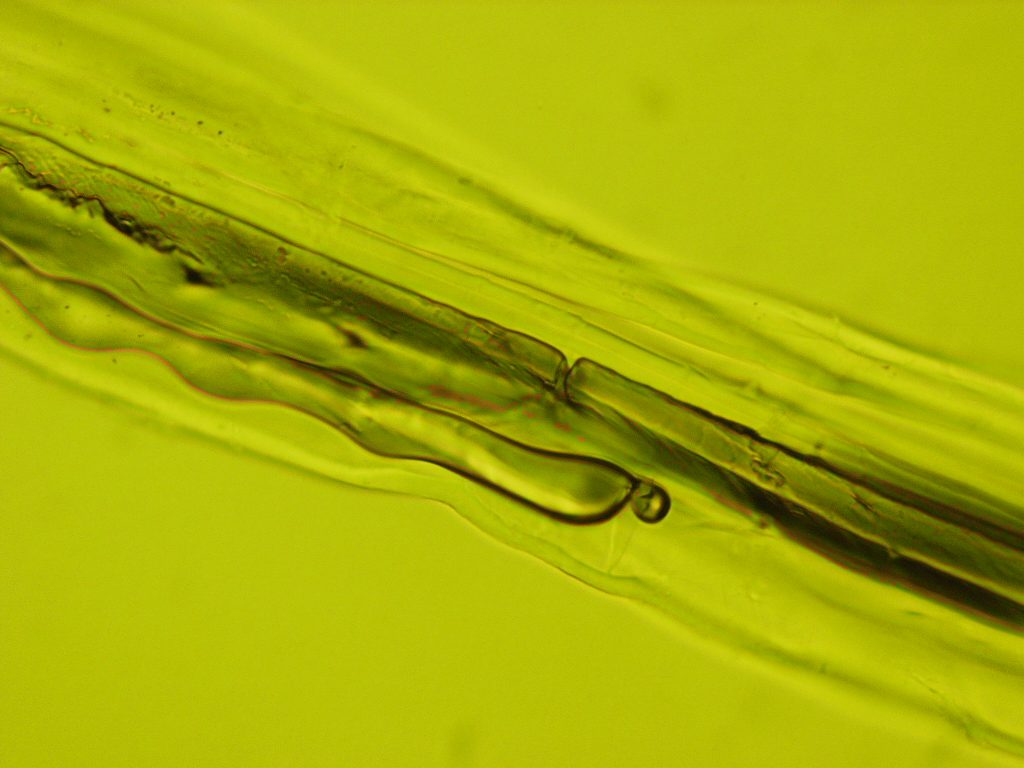 Hemp at 40x magnification. Credit: Edward Dowlman via Wikimedia Commons.
Hemp at 40x magnification. Credit: Edward Dowlman via Wikimedia Commons.
You’ve probably seen signs for delta-8 in smoke shops, bodegas, and other businesses. But what is it? The Cannabis Research Institute explains what delta-8 is, where it comes from, and its potential health risks as an unregulated product.
What is Delta-8?
Delta-8 is an unregulated THC product derived from hemp. Since hemp is legal at the federal level, even in some states where cannabis is not legal, delta-8 products are.
Sometimes delta-8 THC products are referred to as “diet weed” or “weed lite,” because some literature suggests that delta-8 has slightly lower potency. These statements are not supported by clinical trials or other scientific studies.
The difference between delta-8, delta-9, and delta-10
Delta indicates the location of a double bond in the molecular structure. For example, in delta-9-THC, the double bond occurs on the 9th carbon molecule.

Hemp → CBD → Delta-8

To make delta-8-THC, manufacturers must extract CBD from hemp using acid, heat, or an organic solvent.
Delta-9 and Delta-10 side products are minimally produced, which is important once you understand the process of making delta-8.
A chemistry lesson
To get a little further into the differences between the deltas, we need to talk about three chemistry concepts: chirality, enantiomers, and stereoisomerism.
One easy way to think about chirality is mirror images. Turn both of your hands palm up and they’re mirror images of each other; you have a right hand and a left hand. You can also think of it as the opposite of symmetry.

Image courtesy of the Khan Academy lesson on chiral drugs and made available through a Creative Commons license. Note: all Khan Academy content is available at www.khanacademy.org.
If one molecule is chiral in relation to another molecule, those two molecules are enantiomers: chemical compounds that are mirror images of one another but not identical. Often enantiomers are visualized as hands, with one molecule being a left hand and one being a right hand.
Two pairs of enantiomers means that there are four possible forms that THC could take when its chirality is taken into consideration.

THC is known as ‘Δ9-tetrahydrocannabinol’, but the full chemical name of THC is actually ‘(−)-trans–Δ9-tetrahydrocannabinol’.
The (-) and the ‘trans’ prefixes specify spatial features of chirality. A molecule of THC can be either (+) or (−) and be either cis, meaning two atomic groups are on the same side of a double bond, or trans, meaning they are on opposite sides.
The cannabis plant almost exclusively makes its THC as (−)-trans–Δ9-tetrahydrocannabinol.
Likewise, while other chiralities are possible, naturally occurring CBD is in the form (-)-trans-cannabidiol.
When an already right-handed molecule is converted into another molecule, it creates stereoisomers, which are molecules that have atoms linked in the same order as the original, but in a different spatial arrangement. For example, converting CBD into delta-8 or -9 THC generates stereoisomers as side products of the reaction.

In the reaction above, CBD conversion has two pathways:
- alternative forms like delta-9 iso-THC
- delta-8 THC
Why the chirality of THC matters
- Almost all organisms and molecules on the planet are right-handed in terms of molecular makeup.
- Biochemical reactions in the body are directed by enzymes that make sure we have a right-hand molecule our body can use.
- However, in a test tube there may not be enzymes to direct the reaction. The result is a mix of left- and right-handed molecules.
- Think of a THC molecule as having properties of being left-handed or right-handed and also either “up-handed or down-handed.”
- Research has shown that the chirality of cannabinoids is an important factor on their effects within the body.
The problem with stereoisomers
Naturally occurring THC is all right-handed, but that is not true for synthetic delta-8. This mixture of left- and right-handed molecules, called mixed chirality, often results in one molecule being effective, while the other is ineffective at best and toxic at worst. One prominent example is Thalidomide, a drug created to ease morning sickness in pregnant women that had mixed chirality and caused birth defects in the 1950s.
And there’s more …
In addition to the concerns about the molecules themselves, the process to create delta-8 THC can also result in hazardous by-products. Since the natural amount of delta-8 THC in hemp is very low, additional chemicals are needed to convert other cannabinoids in hemp, like CBD, into delta-8 THC.
Products sold as delta-8 are categorized as supplements, which means that neither their manufacturing nor the products themselves are regulated by the FDA, opening the door to dangerous processes:
- some manufacturers may use potentially unsafe household chemicals
- additional chemicals may be used to change the color of the final product
- manufacturing of delta-8 THC products may occur in uncontrolled or unsanitary settings, which may lead to the presence of unsafe contaminants or other potentially harmful substances
As a result, the final delta-8 THC product may have potentially harmful by-products and contaminants. A recent screen of delta-8 products found that the majority contained heavy metal contamination and that the reported compositions of commercial products did not agree with the actual composition.
Higher standards for dispensaries
Cannabis products sold by licensed dispensaries are inspected and regulated. The products at dispensaries should have a Certificate of Analysis (COA): an official, laboratory-prepared document meant to prove the products you are manufacturing are up to your customers’ expectations. Used in various industries where the quality of goods is significantly important to consumers, the COA may have a set of requirements identified by the lab, by regulatory-driven requirements, and/or by standards developed by standard developing organizations.
Is there any benefit to delta-8?
Delta-8 could have a variety of medical benefits beyond pain management. We just need to do more research on its potential therapeutic properties as well as potential adverse effects.
Author: Cannabis Research Institute